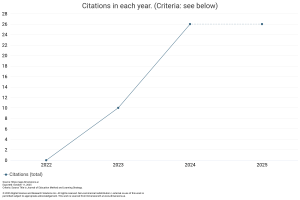Development of A Video Tutorial for Making Digital Motif Designs in Class X Busana 1 SMKN 8 Surabaya
DOI:
https://doi.org/10.59653/jemls.v2i03.912Keywords:
video tutorial, motif design, digitalAbstract
Video tutorials are teaching media that can facilitate student learning activities because of their effectiveness and efficiency. The research has the following objectives: 1). the feasibility level of digital motif design video tutorials 2). student learning outcomes after being shown a video tutorial on designing digital motifs. The study employs the ADDIE R&D (Analysis, Design, Development, Implementation, Evaluation) research approach, utilising a one-shot case study research design. The study was conducted from May to November 2023. the study involved 32 students from Clothing Class 1 at SMKN 8 Surabaya. These six students participated in a limited trial. The research also involved two media experts from Surabaya State University and two material experts from SMKN 8 Surabaya lecturers. Collection methods include level evaluation processes such as video tutorials and assignment grading. The form of conformity evaluation of assignment sheets and learning videos serves as a research tool. Using a descriptive data analysis method, the average effectiveness of learning video services and categorise the learning outcomes based on CTF. Results of this study stated: 1. The development of video tutorials for designing digital motifs was declared feasible to implement with a total score of 4.6. The average score of material experts is 4.4, and media experts 4.8 2. Based on the results of class tests, we can resolve using video tutorial media to create digital motif designs as learning.
Downloads
References
Abdillah Santosa, M., Jayadi, K., & Alimuddin. (2021). Pengembangan Video Tutorial Pembelajaran Menggambar Bentuk Untuk Siswa Kelas Vii. 1 Di Smpn 48 Makassar. 1.
Bestari, A. G., Sugiyem, Asiatun, K., Widarwati, S., & Dwi, A. V. (2022). Pengembangan media video pembelajaran menggunakan ibis paint pada mata kuliah desain kostum.
Dashtestani, R. (2020) Online Courses in Higher Education in Iran: A Stakeholder-Based Investigation into PreserviceTeachers” Acceptance, Learning Achievements, and Satisfaction: A Mixed-Methods Study International Review of Research in Open and Distance Learning, 21(4), 117–142 https://doi.org/10.19173/IRRODL.V21I4.4873
Dikdasmen. (2017). Keputusan Direktur Jenderal Pendidikan Dasar dan Menengah Nomor : 130/D/KEP/KR/2017 tentang Struktur Kurikulum Pendidikan. 5725058(021), 1–4.
Farida, N. A., & Ratyaningrum, F. (2022). Perancangan Video Tutorial Menggambar Ragam Hias Menggunakan Ibispaint X Di Media Sosial Tiktok. Jurnal Seni Rupa, 10(4), 83–96. http:/e/journal.unesa.ac.id/index.php/var
Hasibuan, S. M., Soeprijanto, S., & Supena, A. (2023). The Influence of Tutorial Videos of Making Basic Patterns of Women’s Body on The Learning Outcomes of Deaf Students Jhss (Journal of Humanities and Social Studies), 7(1), 158–162 8
Hegarty, B., & Thompson, M. (2019) teacher’s influence on student engagement: Using smartphones for creating vocational assessment ePortfolios Journal of Information Technology Education: Research, 18, 113–159 https://doi.org/10.28945/4244
Lathifah, R. R., & Hidayati, L. (2023). Pengembangan Video Tutorial Menggambar Desain Rok Secara Digital di Kelas Busana 1 SMK Negeri 2 Tuban. Journal on Education, 5(2), 1779–1789 19
Makarim, N. (2022 Transforming Education Summi d/.
Mayer, R. E. (2009 ia learning and ed Cambridge University Press https://doi.org/https://doi.org/10.1017/CBO9780511811678
Neimar, M., Novita, N., & Fitriana, F. (2022). Penggunaan Aplikasi Berbasis Smartphone (Ibis Paint X) Untuk Pengembangan Desain Busana. Unsyiah, 7 No. 4(November), 1–20.
Nurdin, & Munzir. (2019). Pengaruh Lingkungan Belajar Dan Kesiapan Belajar Terhadap Prestasi Belajar Ilmu Pengetahan Sosial. Faktor Jurnal Ilmiah Kependidikan, 6(3), 247–254.
Panta, N. S. (2022) Influence of Fashion Involvement, Attitude, and Price, Toward Purchase Intention of Ethnic Weaving International Journal of Current Science Research and Review, 05(02), 424–434 https://doi.org/10.47191/ijcsrr/v5-i2-16
Pritandhari, M., & Ratnawuri, T. (2015). EVALUASI PENGGUNAAN VIDEO TUTORIAL SEBAGAI MEDIA PEMBELAJARAN SEMESTER IV PROGRAM STUDI PENDIDIKAN EKONOMI UNIVERSITAS MUHAMMADIYAH METRO. 3(2), 11–20.
Ramadani, E. M. (2021). Pengembangan Media Pembelajaran Berbasis Aplikasi Android Menggunakan Powerpoint Ispring Pada Materi Teori Kinetik Gas (Vol. 9, Issue 1) [Universitas Siliwangi Tasikmalaya]. https://doi.org/10.36987/jes.v9i1.2594
Situmorang, H. B., Rahayu, P. M., & Munawwarah, R. (2023). Kebijakan Kurikulum Merdeka Belajar di Sekolah. Jurnal Penelitian, Pendidikan Dan Pengajaran: JPPP, 4(2), 117–120. https://doi.org/10.30596/jppp.v4i2.15475
Sugiyono. (2014). Metode Penelitian Pendidikan Pendekatan Kuantitatif, Kualitatif dan R&D. Bandung: Alfabeta.
Surani, Dewi, E. R., & Nahar, N. (2022). Pengembangan Video Tutorial Mendesain Busana Berbasis Aplikasi Ibis Paint X Pada Matakuliah Teknologi Desain Busana Di Stkip Pangeran Antasari. Journal of Comprehensive Science, 1(4), 248–253.
Downloads
Published
How to Cite
Issue
Section
License
Copyright (c) 2024 Shabrina Yasinta Zahra Yuma, Deny Arifiana, Imami Arum Tri Rahayu, Mein Kharnolis

This work is licensed under a Creative Commons Attribution-ShareAlike 4.0 International License.
Authors who publish with this journal agree to the following terms:
- Authors retain copyright and grant the journal right of first publication with the work simultaneously licensed under a Creative Commons Attribution-ShareAlike that allows others to share the work with an acknowledgement of the work's authorship and initial publication in this journal.
- Authors are able to enter into separate, additional contractual arrangements for the non-exclusive distribution of the journal's published version of the work (e.g., post it to an institutional repository or publish it in a book), with an acknowledgement of its initial publication in this journal.
- Authors are permitted and encouraged to post their work online (e.g., in institutional repositories or on their website) prior to and during the submission process, as it can lead to productive exchanges, as well as earlier and greater citation of published work (See The Effect of Open Access).
























